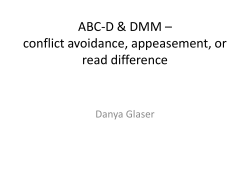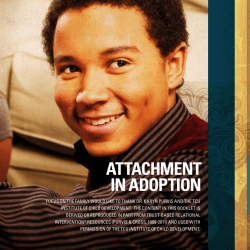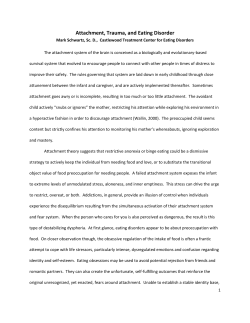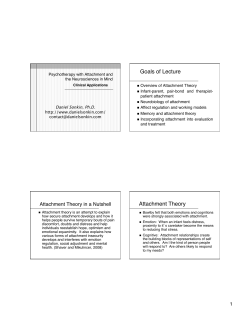
DISMISSIVE ATTACHMENT AND VIOLENT MEDIA 1 Running head:
Running head: DISMISSIVE ATTACHMENT AND VIOLENT MEDIA The running head is a shorter version of your title. It is used as a search identifier in databases. The title should be descriptive of the content and interesting enough to get the reader’s attention. The title appears centered and in 12 point Times New Roman font. 1 The running head is a maximum of 50 characters (including spaces and punctuation) and appears in the top left hand corner of every page. The words "Running head" only occur on the first page. Dismissive Attachment and Violent Media: A Fatal Combination in Ted Bundy Barbara Bryan University of Ontario Institute of Technology Information about the purpose is in the purple boxes. Information about formatting is in the blue boxes. Centre and double space your name (the author) and the institutional affiliation. DISMISSIVE ATTACHMENT AND VIOLENT MEDIA The title appears in full centered at the beginning of the body of the paper. 2 Dismissive Attachment and Violent Media: A Fatal Combination in Ted Bundy In this paper a serial killer will be examined in light of two psychological explanations. Page numbers The serial killer examined in this paper will be Ted Bundy. His crimes will be briefly described, appear consecutively in the top The unless greater detail is needed to enhance a further understanding. Following that will be a right hand introduction of your paper description of background characteristics of Ted Bundy that are relevant to the issues within this corner on each page. should include a paper. The first psychological explanation that will be described and then applied to Ted Bundy They start description on the title of the page. is that of attachment. Specifically the idea of the avoidant-dismissive attachment style will be variables or arguments explored in relation to Bundy. The other psychological explanation is that violent media and your NOTE: thesis. stimulates aggression. These factors, in combination with other risk factors allowed Ted Bundy double spacing, 1 inch to become the sadistic sexual killer that he was. margins and Times New The Serial Killer Roman font. Ted Bundy was a prolific serial killer. He claimed the lives of at least 25 young women and estimates range upwards of 35 (Bell, 2007; Rule, 1980). Bundy was thought to be a sexual sadist, which is evidenced by the details of his crime. For example, in one attack he shoved a bed In-text citations post into the vagina of a victim (Bell, 2007; Rule, 1980). As far as anyone knows the murders he include the authors’ names and the year of committed took place between 1974 and 1978 (Rule, 1980). All of his victims were female publication. When citing (Rule, 1980). more than one work in one Bundy‟s mother, Eleanor Cowell, also called Louise, came from a strict religious family citation the work appears alphabetically. (Rule, 1980). She became pregnant with Ted at the age of twenty-two while she was unwed (Rule, 1980). As such, she was sent to an institution for unwed mothers, and that is where Theodore Robert Cowell was born on the 24th of November, 1946 (Rule, 1980). Ted and his mother Louise returned to her parent‟s house in Philadelphia where Ted was told to call his DISMISSIVE ATTACHMENT AND VIOLENT MEDIA 3 grandparents mother and father (Rule, 1980). Bundy loved and respected the man he believed to be his father, despite the reports that Bundy‟s grandfather had an eruptive temper and enjoyed pornography (Bundy & Dobson, 2004; Rule, 1980). When Ted was four years old Louise took Headings and subheadings help the reader to follow ideas and arguments. Using headings and subheadings when writing can help you organize your ideas more easily. Headings and subheadings follow specific rules. Each level of heading is formatted differently. Here only one level is being used. It appears centered and boldfaced according the updated 6th edition of the APA Publication Manual. Ted to live in the state of Washington with other family members (Rule, 1980). This separation from Ted‟s biological grandfather is said to have been a traumatic event for Ted as he had formed a bond with his grandfather (Rule, 1980). After the move Louise married a military cook named Johnnie Culpepper Bundy in 1951 (Rule, 1980). Although Bundy‟s stepfather Johnnie engaged in many activities with Ted while Ted was growing up, the two never really formed any sort of bond (Rule, 1980). Bundy was described as being „removed‟ and „uncomfortable‟ with Johnnie (Rule, 1980). As well, there are reports that Bundy‟s stepfather engaged in abusive punishment (Rule, 1980). Even though it is reported that Bundy says he did not grow up in an abusive household, he may have been abused with a belt as a child and adolescent, justifying such actions as “punishment” (Bundy & Dobson, 2004; Rule, 1980). This may have contributed to an avoidant dismissive personality, which in turn would be conducive to murder. Attachment Theory Attachment theory was founded by Bowlby (1969), but has gained the attention of many other researchers as well (Ainsworth, 1979; Birnbaum, 2007; Bowlby, 1969; Burton & Lyn, 2004). Attachment theory has an evolutionary basis and posits that infants form attachments to a caregiver to ensure their survival (Birnbaum, 2007). Different attachment styles will develop depending on the relationship between the infant and caregiver, and specifically the quality of interactions with the caregiver (Birnbaum, 2007). If a caregiver is consistently attentive and nurturing a person will grow to have a secure attachment style in which they can develop healthy relationships (Birnbaum, 2007). Whereas, if a caregiver is inconsistent in the way and amount of DISMISSIVE ATTACHMENT AND VIOLENT MEDIA 4 time spent with an infant then that infant will grow to be a person that may end up developing an insecure attachment style (Birnbaum, 2007). It is suggested that there are two different ways of responding to inconsistency and neglect during infancy (Birnbaum, 2007), however only one of those is of importance here, which is to “deactivate” (Birnbaum, 2007). In this way of responding an infant becomes withdrawn and distances themselves from their caregiver (Birnbaum, 2007). This would be an example of an avoidant-dismissive attachment style, which is of interest to this paper. Attachment theorists suggest that a “disruption” in attachments that are developing in infancy and childhood will lead to adjustment problems in adulthood concerning relationships and self regulation (Feerick, Haugaard & Hien, 2002). It has been found that people with the avoidant-dismissive attachment style would not have had a good relationship with their fathers while growing up, and also do not continue to talk to their parents as they are in adulthood (Arrigo & Griffin, 2004). There have been studies that show that maltreatment (read: abuse) of a child is linked to insecure attachment styles both in the childhood and adulthood Titles written in the body of the paper are given in full and italicized. (Feerick, Haugaard & Hien, 2002). As well, a study by Feerick, Haugaard and Hien (2002) entitled Child Maltreatment and Adulthood Violence: The Contribution of Attachment and Drug Abuse found that insecure attachment styles are a risk factor in the victimization and perpetration of violence. It is the opinion of this paper that Ted Bundy developed an avoidant-dismissive attachment style. Bundy did not know his biological father (Rule, 1980). As stated before Bundy did not have a good relationship with his stepfather, which has been described as a characteristic of someone with a dismissive attachment style (Arrigo & Griffin, 2004). As well, when Bundy was four years old he was taken from his grandparents, who he believed were his parents (Rule, 1980). Leaving his grandfather may have been a “disruption” in the development of a DISMISSIVE ATTACHMENT AND VIOLENT MEDIA 5 relationship with someone very important to Bundy, which could have initiated the development of the dismissive attachment style. However, that which initiated the development of a dismissive attachment style also could have been that Bundy was born inside an institution for unwed mothers. In such an institution it may not have been a nurturing environment in which Bundy could receive a lot of attention from his mother. Another fact that may illuminate characteristics that allowed Bundy to develop a dismissive attachment style is that he was abused by his stepfather with a belt in what has been referred to as “corporal punishment” (Rule, 1980). Bundy certainly possessed some characteristics that evidenced an avoidant-dismissive attachment style; however there are limitations to applying this theory to Bundy as well. The study that found that abuse in childhood is associated with perpetration and victimization of violence had conducted their research on a sample of women (Feerick, Haugaard & Hien, 2002). As well, there is not a massive amount of evidence that says that Bundy did not maintain a relationship with his parents as he got older. It is possible that such an area of Bundy‟s life was not of interest to authors that wrote about him and therefore evidence about his relationships with his parents, Johnnie and Louise, is limited. Violent Media Another psychological explanation that can be applied to Ted Bundy is that of violence in the media and its link to aggression. There have been a larger number of studies, both qualitative and quantitative, that have been conducted over the last few decades and have found that violence within the media is a significant factor in aggressive behaviour for all age groups (Anderson & Bushman, 2001). In fact, mass media helps to shape and reflect cultural values (Shope, 2004). Further, studies have shown that exposure to violent pornography increases sexual aggression towards woman (Shope, 2004). Another study also found that being exposed DISMISSIVE ATTACHMENT AND VIOLENT MEDIA 6 to nonviolent or violent pornography increases attitudes in sexual aggression (Shope, 2004). Moreover, another study found that the more pornography is used and the more violent the content of the pornography the more likely the men were going to be involved in sexual assault or harassment (Shope, 2004). It has also been found that criminal populations are more aroused by pornography than non-criminal populations (Shope, 2004). However, not every male that watches pornography is sexually aggressive; therefore there are other contributory factors that play a role when a man commits rape or sexual assault (Shope, 2004). This paper contends that one of the other contributory factors that made Ted Bundy sexually aggressive was his insecure, dismissive attachment style along with the combination of the harmful effects of pornography. It was not until after Bundy was convicted and going to be executed that he spoke up about his use of pornography, and when he did finally speak up he allowed Dr. James Dobson to conduct an interview (Bundy & Dobson, 2004). It is speculative why Bundy allowed Dr. James Dobson to interview him, but it would probably have to do with the fact that Bundy was condemning pornography as does Dr. Dobson and they were both republicans (Bundy & Dobson, 2004). The interview is not evidence that pornography does cause harm, however it is interesting to note that Bundy recognized that the pornography he viewed had an effect on him. It was reported that Bundy started to view pornography when he was 13 years old (Bundy & Dobson, 2004). He also admitted to viewing violent pornography (Bundy & Dobson, 2004). As well, Bundy recognized that the media he was consuming was shaping his views or “molding” him, as he put it (Bundy & Dobson, 2004). Given the findings about aggression and violent media, particularly pornography, it would be a wonder that pornography did not have an influence on someone that found extreme gratification from the dehumanization and destruction of other people. DISMISSIVE ATTACHMENT AND VIOLENT MEDIA 7 Conclusion It is There are quite a few limitations when trying to analyze Ted Bundy from an attachment important to discuss limitations framework and attempting to find a link between his consumption of violent media and his of the research. crimes. Some of the limitations illuminated include a study whose sample was female instead of Acknowledging problems, male; some of the research is not generalizable to the larger population; as well, there may not be the implications enough information about the subject, Bundy, and it may be impossible to discover anymore of those problems information as he is no longer alive (Rule, 1980). These are a few of the limitations but certainly and posing potential not an exhaustive list. Despite the limitations, the attachment framework may enable discovery solutions is important about why someone would commit atrocities like those done by Ted Bundy. As well, because you want the highlighting the information about pornography, aggression and criminality it is shown that there reader to have a full is reason for further investigation as to the direct and indirect effects of viewing violent understanding of the pornography. One might want to think twice before allowing a population that objectifies women issues. to view violent pornography as it perpetuates and contributes to aggression and negative attitudes. If Ted Bundy did not have access to violent media and was able to form a secure attachment to a caregiver he may not have become a violent sexual serial killer. The conclusion should recap the arguments and main points and discuss further research. DISMISSIVE ATTACHMENT AND VIOLENT MEDIA The reference section appears as a separate section beginning with a new page. The title “References” is centered and bolded. All entries are listed in alphabetic order. The format will depend on the type of source. The references are double spaced. Every source used to build your paper must appear in this list. 8 References Ainsworth, M. D. S. (1979). Infant-mother attachment. American Psychologist, 34, 932-937. Anderson, C. A. & Bushman, B. J. (2001). Media violence and American public: Scientific fact versus media misinformation. American Psychologist, 56, 477-489. Arrigo, B. A. & Griffin, A. (2004). Serial murder and the case of Aileen Wuornos: Attachment theory, psychopathy and predatory aggression. Behavioral Sciences and Law, 22, 375393. Bell, R. (2007). The Ted Bundy story: The early years. Retrieved from http://www.crimelibrary.com/serial_killers/notorious/bundy/2.html. Birnbaum, G. E. (2007). Beyond the borders of reality: Attachment orientations and sexual fantasies. Personal Relationships, 14, 321-342. Bowlby, J. (1969). Attachment and loss: Attachment, volume 1. London, UK: Hogarth Bundy, T. & Dobson, J. (2004, January 27). The last interview with Ted Bundy. [Radio interview]. Retrieved from http://everything2.com/index.pl?node_id=1515802 Burton, D. L. & Lyn, T. S. (2004). Adult attachment and sexual offender status. American Journal of Orthopsychiatry, 2, 150-159. Feerick, M. M., Haugaard J. J. & Hein, D. A. (2002). Child maltreatment and adulthood Journal articles violence: The contribution of attachment and drug abuse. Child Maltreatment, 7, 226 - that are found through electroni databases are 240. doi: 10.1177/107755950200700305 identified by the digital object Rule, A. (1980). The stranger beside me. New York: W. W. Norton. identifier or DOI Shope, J. H. (2004). When words are not enough: The search for the effect of pornography on number shown here. abused women. Violence Against Women, 10, 56-72. doi: 10.1177/1077801203256003
© Copyright 2025









